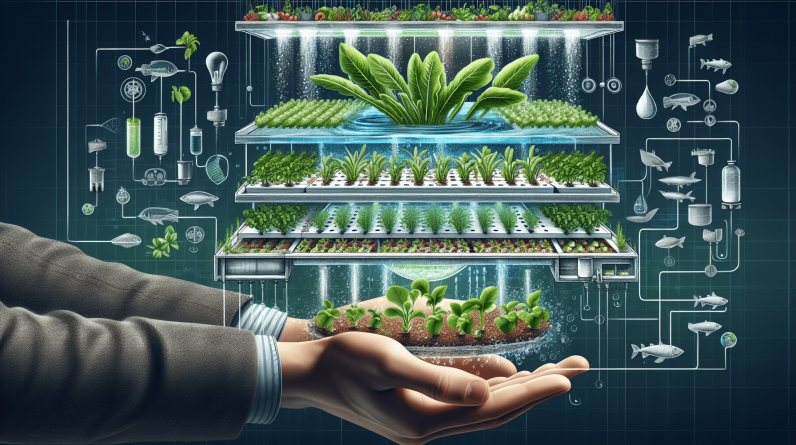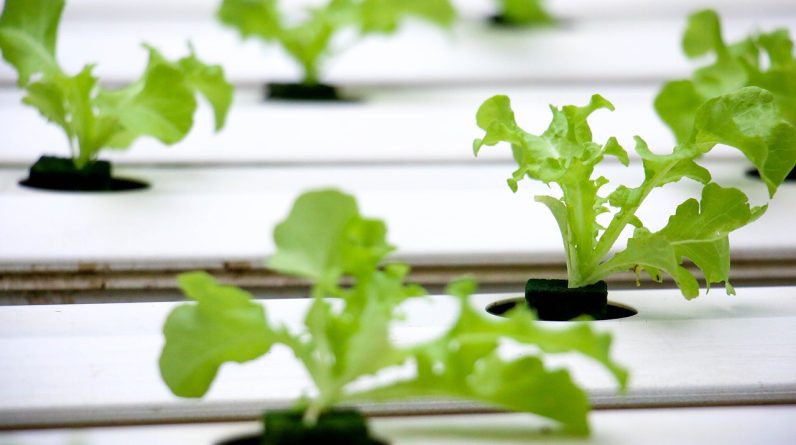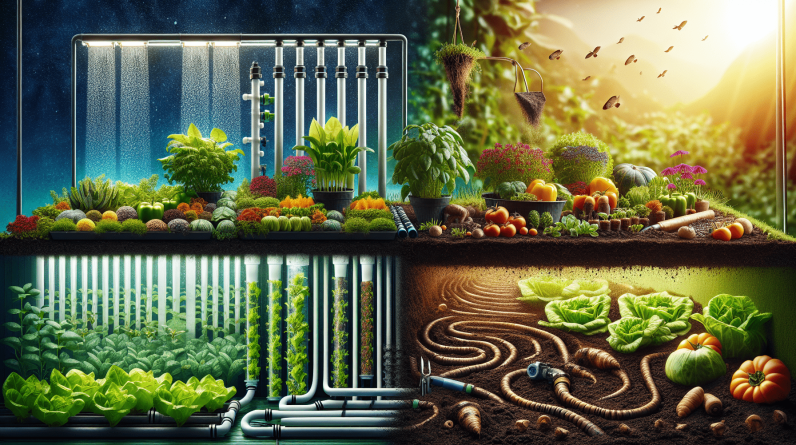
In the world of gardening, there are two popular methods that ring a bell – hydroponic gardening and traditional soil gardening. When it comes to growing plants, both techniques have their own set of advantages and challenges. Hydroponic gardening, a method that involves growing plants without soil, is gaining popularity due to its ability to save space and water. On the other hand, traditional soil gardening, the age-old practice of growing plants in the ground, offers a more natural approach with the added benefit of soil nutrients. Both methods have their avid supporters, but which one is truly superior? Let’s delve into the intriguing debate of hydroponic gardening versus traditional soil gardening and discover the pros and cons of each method.
Advantages of Hydroponic Gardening
Higher plant yields
One of the major advantages of hydroponic gardening is the ability to achieve higher plant yields compared to traditional soil gardening. In a hydroponic system, plants have constant access to water, nutrients, and oxygen, which promotes optimal growth and development. The absence of soil also eliminates the competition for nutrients and allows plants to allocate more energy towards producing fruits or vegetables. Additionally, the controlled environment of a hydroponic system enables growers to fine-tune factors such as light intensity, temperature, and pH levels, further enhancing plant productivity.
Faster growth rate
Another advantage of hydroponic gardening is the significant increase in growth rate. Without the need for plants to search for nutrients in the soil, they can direct all their energy towards vegetative and reproductive growth. The precise control of environmental conditions in hydroponics, such as nutrient concentration and pH levels, ensures that the plants receive the optimal conditions for rapid growth. As a result, hydroponically grown plants tend to reach maturity faster than those grown in traditional soil gardens.
Conservation of water
Hydroponic gardening is highly efficient in water usage compared to traditional soil gardening. In a hydroponic system, water is recirculated and reused multiple times, significantly reducing the overall water consumption. This is achieved through technologies such as drip irrigation, nutrient film technique (NFT), or aeroponics, where water is delivered directly to the plant roots with minimal evaporation or runoff. As water scarcity becomes a growing concern, hydroponics offers an eco-friendly solution by minimizing water waste and promoting sustainable water management practices.
Control over nutrient intake
One of the key advantages of hydroponic gardening is the precise control over nutrient intake for plants. In traditional soil gardening, the availability of nutrients is dependent on the composition of the soil, which can vary significantly. In hydroponics, growers can tailor the nutrient solution to meet the specific needs of each plant species, ensuring they receive an optimal blend of essential elements for their growth and development. This level of control allows for consistent nutrient uptake by plants, leading to healthier and more productive crops.
Less dependence on weather conditions
Hydroponic gardening provides growers with less dependence on weather conditions, making it an ideal option for year-round cultivation. In traditional soil gardening, extreme weather events such as droughts, floods, or frost can have a detrimental impact on plant growth and yield. By growing plants in a controlled environment indoors or in greenhouses, hydroponic growers can protect their crops from adverse weather conditions. This independence from natural weather patterns allows for a more stable and reliable production throughout the year.
Advantages of Traditional Soil Gardening
Greater accessibility
Traditional soil gardening holds the advantage of greater accessibility for most people. Since soil is the natural medium for plant growth, soil gardening can be practiced almost anywhere, from backyard gardens to community plots. The accessibility of soil gardening allows individuals of all backgrounds to engage in gardening and enjoy the benefits of growing their own food. Additionally, traditional soil gardening methods are deeply rooted in cultural practices, making it more accessible and relatable for gardeners.
Lower initial setup costs
Compared to the upfront investments required for hydroponic systems, traditional soil gardening generally has lower initial setup costs. Soil gardening mainly relies on the availability of fertile soil, sunlight, and basic gardening tools. With minimal requirements for specialized equipment or infrastructure, soil gardening can be an affordable option for both small-scale and large-scale cultivation. This lower barrier to entry makes traditional gardening accessible to individuals or communities with limited financial resources.
Natural growth environment
Traditional soil gardening offers plants a natural growth environment rich in a diverse range of microorganisms. Soil contains beneficial bacteria, fungi, and other microorganisms that contribute to the overall health of plants. These microorganisms interact with the plant roots, facilitating nutrient uptake, improving soil structure, and protecting against soil-borne diseases. The symbiotic relationship between plants and soil microbiota enhances the overall resilience of the garden ecosystem, promoting sustainable and biologically diverse plant growth.
Enhanced microbial activity
In traditional soil gardening, the presence of microorganisms in the soil leads to enhanced microbial activity. This activity contributes to the breakdown of organic matter, releasing essential nutrients that become available for plant uptake. The cycling of organic matter by soil microorganisms also improves soil structure and increases its water-holding capacity. This natural process helps to maintain the fertility of the soil over time without the need for constant nutrient supplementation. The high microbial activity in soil gardening supports a healthy and self-sustaining ecosystem.
Ability to reuse soil
A significant advantage of traditional soil gardening is the ability to reuse the soil for multiple growing seasons. With proper care and management, the soil can be revitalized between planting cycles, allowing for continuous cultivation without the need for additional growing media. This practice not only reduces the cost and effort associated with soil replenishment but also promotes sustainable gardening practices. Reusing soil helps maintain the soil’s natural balance of nutrients and encourages the development of a robust soil ecosystem.

Disadvantages of Hydroponic Gardening
Higher setup costs
One of the main disadvantages of hydroponic gardening is the higher initial setup costs involved compared to traditional soil gardening. Hydroponic systems require specialized equipment such as grow lights, pumps, timers, and nutrient solutions, which can be expensive to acquire. Additionally, the construction or purchase of a suitable hydroponic structure, such as a greenhouse or indoor grow room, adds to the overall investment. While the cost of hydroponics can be offset by higher crop yields and faster growth rates, it may pose a financial challenge for some aspiring growers.
Requires technical knowledge and equipment
Hydroponic gardening requires a certain level of technical knowledge and expertise to set up and maintain the system effectively. Growers need to understand the principles of hydroponics, including nutrient management, pH balancing, water circulation, and pest control. This knowledge is crucial for optimizing plant growth and preventing system failures. Furthermore, the operation of hydroponic equipment and monitoring of environmental conditions may require some level of technical proficiency. Acquiring the necessary knowledge and skills can be time-consuming and may involve a learning curve for beginners.
Reliance on artificial nutrient solutions
Without access to natural soil, hydroponic plants rely entirely on artificial nutrient solutions for their growth. These nutrient solutions need to be carefully formulated and provided to the plants in a controlled manner. The reliance on synthetic nutrients may be seen as a disadvantage by those who prefer organic or natural methods of gardening. Additionally, the cost and availability of commercially prepared nutrient solutions can pose a challenge for some hydroponic growers, limiting their choices and potentially adding to the overall expenses.
Power dependency
Hydroponic systems require a continuous supply of electricity to power various components, including grow lights, pumps, and ventilation systems. This power dependency can be a disadvantage if there are frequent power outages or unreliable electrical infrastructure. Growers need to invest in backup power sources or alternative energy solutions to ensure the uninterrupted operation of the hydroponic system. The reliance on electricity adds to the overall cost of hydroponic gardening, as well as the potential environmental impact associated with energy consumption.
Susceptibility to system failures
Hydroponic systems are more susceptible to system failures compared to traditional soil gardens. Any malfunction or disruption in the equipment, such as pump failure or pH imbalance, can quickly impact plant health and productivity. Without an immediate intervention, the entire crop can be at risk. This vulnerability to system failures requires regular monitoring and maintenance by growers to avoid unexpected losses. Additionally, the complexity of hydroponic systems means that troubleshooting and addressing technical issues may require specialized knowledge or professional assistance.
Disadvantages of Traditional Soil Gardening
Limited space utilization
Traditional soil gardening is limited by the available space and soil conditions. In small urban environments or areas with poor soil quality, it may be challenging to establish a productive garden. The constraints of limited space can restrict the type and quantity of plants that can be grown. This limitation can be a disadvantage for individuals or communities who wish to maximize their cultivation in limited areas. However, creative solutions such as vertical gardening or container gardening can help overcome these space limitations to some extent.
Slower growth rate
Compared to the faster growth rate of hydroponically grown plants, traditional soil gardening tends to have a slower growth rate. The natural variations in the nutrient content and structure of soil can affect plant growth, resulting in slower development and potentially delayed harvest. Soil variations can also create uneven nutrient distribution, leading to some plants receiving more or fewer nutrients than required. This variability in growth rate may not be ideal for commercial growers who seek efficient and consistent crop production.
Higher water consumption
Traditional soil gardening generally requires higher water consumption compared to hydroponic systems. In soil gardens, water can be lost through evaporation, percolation, or inefficient watering practices. Climatic factors, such as temperature and rainfall, can further influence the water requirements of the plants. Higher water consumption may pose challenges in regions with limited water resources or during periods of drought. Proper water management practices, including mulching and drip irrigation, can help mitigate excessive water usage in soil gardening.
Risk of soil-borne diseases
One of the disadvantages of traditional soil gardening is the risk of soil-borne diseases. Soil is a natural reservoir for various pathogens, pests, and weed seeds that can harm plants. These diseases can spread through the soil, affecting the entire garden and potentially leading to crop losses. Managing soil-borne diseases often involves the use of chemical pesticides or the implementation of crop rotation strategies. However, these measures may not always be effective in eliminating or preventing the emergence of such diseases, posing a continuous risk to soil-grown crops.
Inconsistent nutrient availability
Unlike hydroponic systems with precise nutrient control, traditional soil gardening can have inconsistent nutrient availability for plants. The nutrient content in soil can vary depending on factors such as soil composition, organic matter content, and previous crop residues. This variability can lead to imbalances, deficiencies, or toxicities in nutrient uptake by plants, affecting their overall health and productivity. Regular soil testing and supplementation with organic matter or fertilizers are common practices in traditional soil gardening to address nutrient deficiencies, but maintaining consistent nutrient availability can be challenging.

Water Efficiency: Hydroponics vs. Soil Gardening
Hydroponics: Precise water control and less wastage
One of the key advantages of hydroponic gardening is its high water efficiency. In hydroponics, water is precisely delivered directly to the plant roots, minimizing wastage through evaporation or runoff. The recirculation of water within the system allows for the reuse of water, reducing overall water consumption. Additionally, hydroponic systems often incorporate water-saving technologies such as drip irrigation or NFT, further enhancing water efficiency. With improved control over water usage, hydroponics offers a sustainable solution to conserve water resources in comparison to traditional soil gardening.
Soil Gardening: Water absorption limitations and potential wastage
Traditional soil gardening faces limitations in water absorption and has the potential for water wastage. Soil composition, structure, and texture can affect the water-holding capacity and drainage characteristics, impacting plant water availability. Water can be lost through evaporation or surface runoff if proper irrigation practices are not implemented. The variations in soil moisture levels due to uneven water distribution may also result in under or overwatering of plants. Though water conservation measures such as mulching and using efficient irrigation methods can mitigate wastage, soil gardening generally requires more water compared to hydroponics.
Nutrient Control: Hydroponics vs. Soil Gardening
Hydroponics: Customizable nutrient solutions for optimized plant growth
Hydroponic gardening excels in nutrient control through the use of customizable nutrient solutions. Growers can precisely tailor the nutrient solutions to meet the specific needs of different plant species or growth stages. This optimized nutrient delivery ensures that plants receive the right balance of essential elements required for their growth and development. The ability to adjust nutrient concentrations and ratios in hydroponic systems allows growers to optimize plant health, productivity, and even crop flavor. The precise nutrient control in hydroponics eliminates the natural variability in nutrient content found in soil gardening.
Soil Gardening: Natural variability in nutrient content and limited control
Traditional soil gardening experiences natural variability in the nutrient content of the soil, making nutrient control more challenging. Soil composition, organic matter content, and previous crop residues influence the availability and levels of nutrients. While organic matter and compost can improve soil fertility over time, achieving precise nutrient control is more challenging compared to hydroponics. Nutrient deficiencies or imbalances may arise due to the intrinsic properties of the soil, requiring regular soil testing and amendments to maintain optimal nutrient availability for plants.
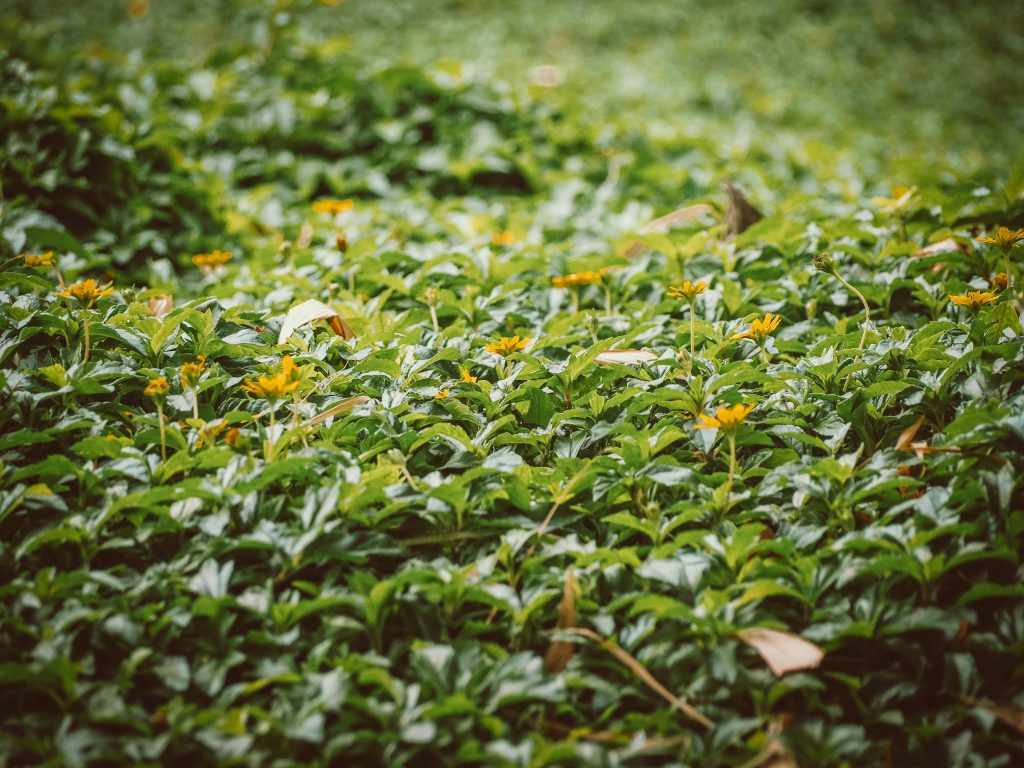
Plant Growth Rate: Hydroponics vs. Soil Gardening
Hydroponics: Stimulates faster growth due to optimized conditions
Hydroponic gardening stimulates faster plant growth due to the optimized conditions provided to the plants. The absence of soil eliminates the need for plants to allocate energy towards root expansion, leading to faster vegetative and reproductive growth. The precise control of environmental factors such as light, temperature, humidity, and pH levels allows growers to create ideal conditions for accelerated growth. These optimized conditions, combined with the consistent availability of water and nutrients, contribute to the faster growth rate observed in hydroponically grown plants.
Soil Gardening: Slower growth due to soil variations and nutrient limitations
In traditional soil gardening, the growth rate of plants can be slower compared to hydroponics. Soil variations, nutrient deficiencies, and imbalances can limit the growth potential of plants, leading to slower development and maturity. The variations in soil texture, fertility, and water availability across different garden areas can create disparities in the growth rates of plants. Moreover, nutrient limitations in the soil require plants to rely on natural soil processes for nutrient release and uptake, which can be slower compared to the controlled nutrient delivery in hydroponics.
Environmental Impact: Hydroponics vs. Soil Gardening
Hydroponics: Reduced use of pesticides and chemical fertilizers
Hydroponic gardening reduces the use of pesticides and chemical fertilizers, leading to a lower environmental impact compared to traditional soil gardening. In hydroponics, the controlled environment minimizes the risk of pest infestations, reducing the need for chemical pesticides. Furthermore, the precise control over nutrient solutions allows growers to provide plants with optimal nutrition without excess fertilizer application. The reduction in chemical inputs contributes to improved water quality, reduced soil pollution, and a more sustainable approach to cultivation.
Soil Gardening: Potential soil erosion, nutrient runoff, and reliance on pesticides
Traditional soil gardening has the potential for negative environmental impacts such as soil erosion, nutrient runoff, and reliance on pesticides. Practices such as plowing, tilling, or improper soil management can lead to soil erosion, degrading soil quality and contributing to sedimentation in water bodies. Nutrient runoff from the soil can contaminate water sources, causing eutrophication and ecological imbalances. Additionally, traditional soil gardening often relies on chemical pesticides and fertilizers to control pests and enhance plant growth, introducing potential risks to the environment. Proper soil conservation practices and the use of organic and sustainable techniques can mitigate these impacts.
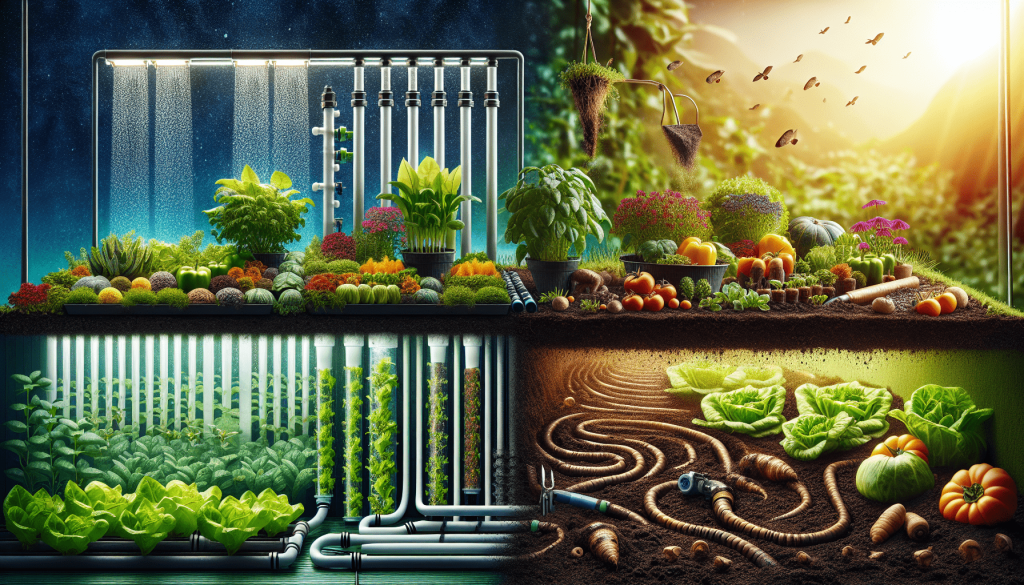
Crop Variety: Hydroponics vs. Soil Gardening
Hydroponics: Enables growth of a wide range of crops, including those with shallow roots
Hydroponic gardening enables the growth of a wide variety of crops, including those with shallow roots. In a hydroponic system, plants are not limited by the depth or composition of the soil, allowing for the cultivation of crops that may struggle in traditional soil gardens. Leafy greens, herbs, strawberries, and many other crops thrive in hydroponics due to the controlled environment and optimized nutrient delivery. The versatility of hydroponic systems makes it possible to grow diverse crops, expanding the options for growers and consumers alike.
Soil Gardening: Limited crop variety based on soil conditions and depth
Traditional soil gardening has limitations on crop variety based on the specific soil conditions and depth required by different plants. Certain crops may have specific soil pH, drainage, or fertility requirements that are difficult to replicate in all gardening locations. Some plants, such as root vegetables or perennials with deep taproots, may depend on deep soils for successful growth. The composition of the soil, including clay, sand, loam, or silt, can also restrict the range of crops that can be grown. Soil gardening generally requires careful selection and adaptation of crops based on the available soil conditions.
Sustainability: Hydroponics vs. Soil Gardening
Hydroponics: Efficient resource use, reduced land requirement, and potential for vertical farming
Hydroponic gardening offers sustainability benefits through efficient resource use, reduced land requirement, and the potential for vertical farming. The controlled environment of hydroponics allows for precise resource allocation, minimizing water and nutrient waste. The elimination of soil reduces the need for land-intensive farming, making hydroponics suitable for urban or indoor cultivation. Vertical farming, a form of hydroponics, maximizes land utilization by stacking plant beds vertically, significantly increasing crop production per unit area. These sustainable practices in hydroponics help to conserve land and resources for future generations.
Soil Gardening: Uses natural land resources, potential for crop rotation, and reduced waste management
Traditional soil gardening demonstrates sustainability through the utilization of natural land resources, potential for crop rotation, and reduced waste management. Soil gardening utilizes existing fertile lands and harnesses the natural fertility of the soil to support plant growth. Crop rotation practices in soil gardening help to minimize soil depletion, prevent pests and diseases, and enhance soil health through the diversity of plant species. Additionally, organic waste materials can be composted and returned to the soil as natural fertilizers, reducing the need for external inputs and minimizing waste generation.
In conclusion, both hydroponic gardening and traditional soil gardening offer distinct advantages and disadvantages. Hydroponic gardening excels in higher plant yields, faster growth rates, water efficiency, control over nutrient intake, and reduced dependence on weather conditions. On the other hand, traditional soil gardening provides greater accessibility, lower initial setup costs, a natural growth environment, enhanced microbial activity, and the ability to reuse soil. Considerations such as cost, space availability, technical knowledge, environmental impact, crop variety, and the desired level of control should be taken into account when deciding between hydroponic gardening and traditional soil gardening. Ultimately, the choice depends on the specific needs, resources, and preferences of the individual or community engaged in gardening.




